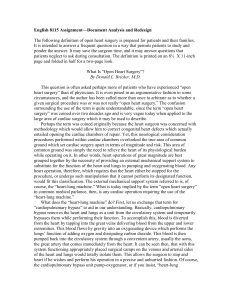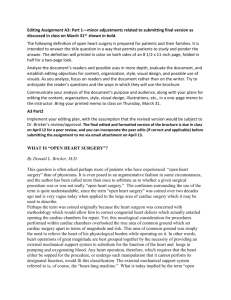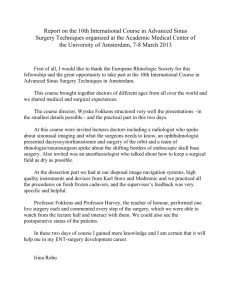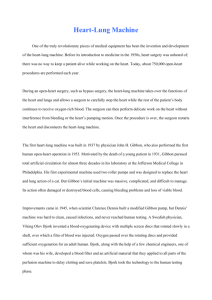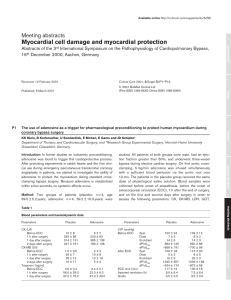Definition of open heart surgery.
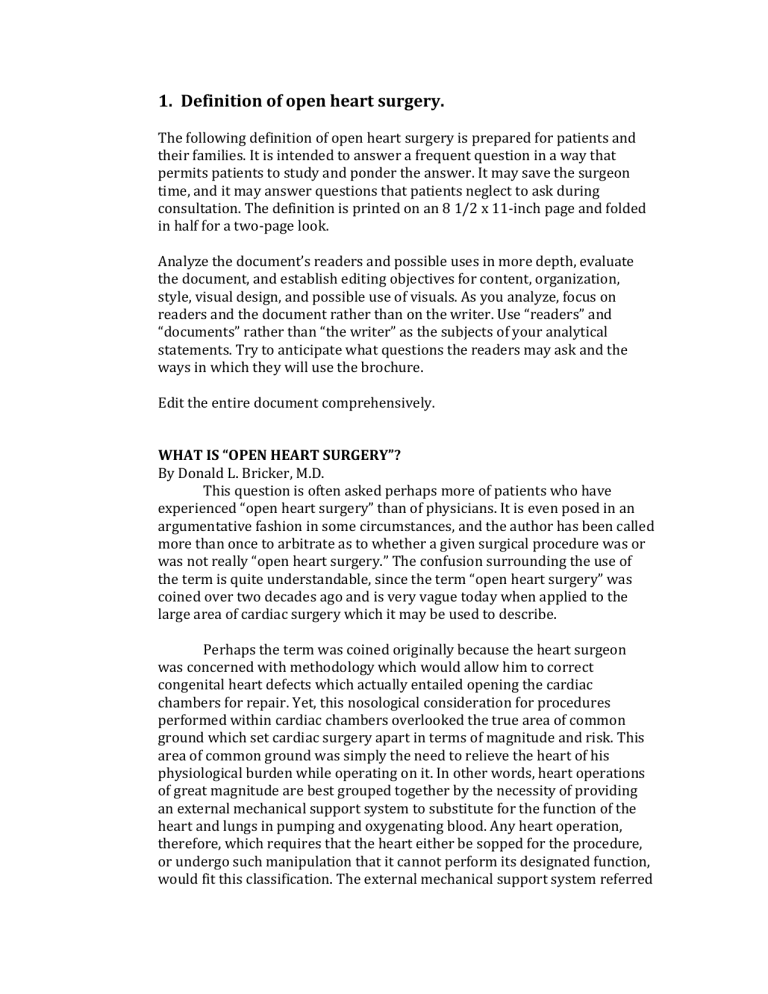
1.
Definition of open heart surgery.
The following definition of open heart surgery is prepared for patients and their families. It is intended to answer a frequent question in a way that permits patients to study and ponder the answer. It may save the surgeon time, and it may answer questions that patients neglect to ask during consultation. The definition is printed on an 8 1/2 x 11-inch page and folded in half for a two-page look.
Analyze the document’s readers and possible uses in more depth, evaluate the document, and establish editing objectives for content, organization, style, visual design, and possible use of visuals. As you analyze, focus on readers and the document rather than on the writer. Use “readers” and
“documents” rather than “the writer” as the subjects of your analytical statements. Try to anticipate what questions the readers may ask and the ways in which they will use the brochure.
Edit the entire document comprehensively.
WHAT IS “OPEN HEART SURGERY”?
By Donald L. Bricker, M.D.
This question is often asked perhaps more of patients who have experienced “open heart surgery” than of physicians. It is even posed in an argumentative fashion in some circumstances, and the author has been called more than once to arbitrate as to whether a given surgical procedure was or was not really “open heart surgery.” The confusion surrounding the use of the term is quite understandable, since the term “open heart surgery” was coined over two decades ago and is very vague today when applied to the large area of cardiac surgery which it may be used to describe.
Perhaps the term was coined originally because the heart surgeon was concerned with methodology which would allow him to correct congenital heart defects which actually entailed opening the cardiac chambers for repair. Yet, this nosological consideration for procedures performed within cardiac chambers overlooked the true area of common ground which set cardiac surgery apart in terms of magnitude and risk. This area of common ground was simply the need to relieve the heart of his physiological burden while operating on it. In other words, heart operations of great magnitude are best grouped together by the necessity of providing an external mechanical support system to substitute for the function of the heart and lungs in pumping and oxygenating blood. Any heart operation, therefore, which requires that the heart either be sopped for the procedure, or undergo such manipulation that it cannot perform its designated function, would fit this classification. The external mechanical support system referred
to is, of course, the “heart-lung machine.” What is today implied by the term
“open heart surgery” in common medical parlance, then, is any cardiac operation requiring the use of the “heart-lung machine.”
What does the “heart-lung machine” do? First, let us exchange that term for “cardiopulmonary bypass” to aid in our understanding. Basically, cardiopulmonary bypass removes the heart and lungs as a unit from the circulatory system and temporarily bypasses them while performing their function. To accomplish this, blood is diverted from the heart by tapping into the great veins delivering blood from the upper and lower extremities. This blood flows by gravity into an oxygenating device which performs the lungs’ function of adding oxygen and dissipating carbon dioxide. This blood is then pumped back into the circulatory system through a convenient artery, usually the aorta, the great artery that comes immediately from the heart. It can be seen then, that with this system functioning, appropriately placed surgical clamps on the venous and arterial sides of the heart and lungs would totally isolate them. This allows the surgeon to stop the heart if he wishes and perform his operation in a precise and unhurried fashion. Of course, the cardiopulmonary bypass unit pump-oxygenator, or if you insist, “heart-lung machine”, cannot do this job indefinitely, but sufficient time is safely at hand with today’s equipment that the surgeon need not hold the concern he once did for the time factor. Improvement in this equipment has, more than any other factor, led to the successes we routinely enjoy today. One question frequently asked is about the blood supply to the heart and lungs themselves during this period of “bypass.” Their blood supply is markedly reduced since they are removed from the circulatory system, but since they are at rest, oxygen requirements are minimal, and for the duration of most procedures no problems are posed.
In conclusion, “open heart surgery” has come to be a less than literal term and in common usage implies a cardiac surgical procedure requiring use of cardiopulmonary bypass. It is this factor which sets the operation apart from other operations on the heart. If your operative procedure was or is to be done under cardiopulmonary bypass, rest assured you have undergone or will undergo “open heart surgery.”
Reprinted by permission of Donald L. Bricker, M.D.
